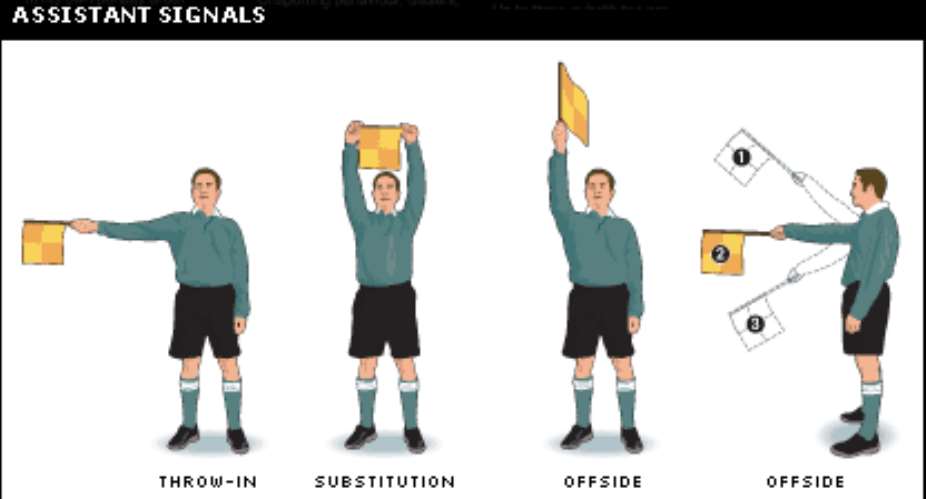In the game of soccer,there are several decisions taken by the referees which spectators may not understand,making the particular game look biased.However,these are some few guidelines which might be of help to spectators,journalists,both home and at stadia during the oncoming African Cup of Nations (Ghana 2008)
That person on the touchline might look as though he's waving in some low flying aircraft but those flags have very important roles.
They used to be called linesmen but now they're referee assistants and they help the referee with offside decisions and signal a number of things, such as throw-ins and substitutions.
So what are these signals?
Well you don't need a degree in semaphore to understand what they all mean.
Here is our guide to the referee assistant signals.
THROW-IN
When the whole of the ball crosses the line, it's time for a throw-in.
The assistant referee will hold up the flag in the direction that the team which is awarded the throw-in is attacking.
The assistant will stand at the point where the ball crossed the line.
But only if the ball goes out in the half of the pitch he is marshalling.
SUBSTITUTION
If the manager decides it's time to change the team then this is the signal you'll see on the touchline.
The arms go up in the air and holding on to both sides of the flag, it is hung above the head of the referee's assistant.
Not the sort of signal you want to see if 30 seconds before you've just blazed a penalty over the bar.
OFFSIDE
There are three different signals for an offside.
But the type of signal is dependent on where the offside offence is committed.
The position where the assistant holds his flag makes it clear to the referee, players and spectators which player is being penalised for offside.
1. FAR SIDE
The first signal is for offsides on the far side of the pitch. The assistant referee will hold the flag out in front of him at above head height.
2. CENTRE
The second signal indicates that a player in the centre of the pitch has strayed offside. The flag will be held out with an outstretched arm at shoulder height.
3. NEAR SIDE
If a player on the side of the pitch nearest to the assistant is deemed to be offside then the flag is pointed down towards the ground in front of the body.





 We’ll no longer tolerate your empty, unwarranted attacks – TUC blasts Prof Adei
We’ll no longer tolerate your empty, unwarranted attacks – TUC blasts Prof Adei
 Bawumia donates GHc200,000 to support Madina fire victims
Bawumia donates GHc200,000 to support Madina fire victims
 IMF to disburse US$360million third tranche to Ghana without creditors MoU
IMF to disburse US$360million third tranche to Ghana without creditors MoU
 Truck owner share insights into train collision incident
Truck owner share insights into train collision incident
 Paramount chief of Bassare Traditional Area passes on
Paramount chief of Bassare Traditional Area passes on
 Two teachers in court over alleged illegal possession of BECE papers
Two teachers in court over alleged illegal possession of BECE papers
 Sunyani: Victim allegedly shot by traditional warriors appeals for justice
Sunyani: Victim allegedly shot by traditional warriors appeals for justice
 Mahama vows to scrap teacher licensure exams, review Free SHS policy
Mahama vows to scrap teacher licensure exams, review Free SHS policy
 Government will replace burnt Madina shops with a new three-story, 120-store fac...
Government will replace burnt Madina shops with a new three-story, 120-store fac...
